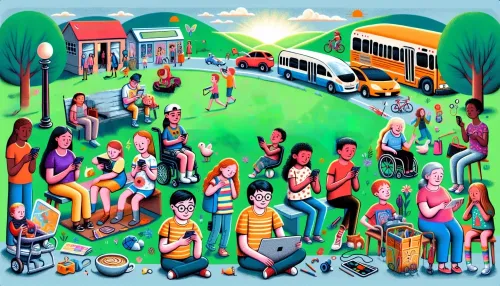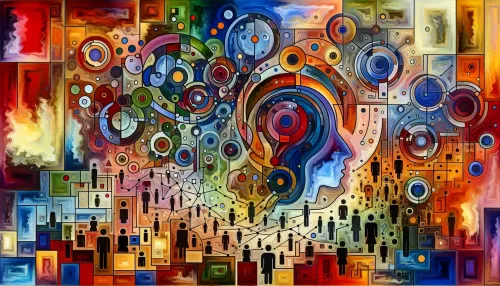The Role of Social Stigma in Autistic Children's Lives: A Comparative Analysis Across Countries

Autism is a complex neurodevelopmental disorder that affects individuals in diverse ways, often presenting challenges related to social interaction, communication, and behavior. While great strides have been made in understanding and supporting autistic children, the social stigma associated with autism remains a significant concern. This article aims to delve into the multifaceted nature of autism stigma, exploring its variations across different cultures and communities. By examining the influence of cultural beliefs on autism stigma and discussing strategies to address stigma in diverse cultural contexts, we can gain insights into creating more inclusive and supportive environments for autistic children globally.
The perception of autism varies widely across different societies, shaping the experiences of autistic individuals and their families. In some regions, autism may be viewed through a primarily medical lens, emphasizing clinical interventions and behavioral therapies. Conversely, in other cultures, there might be a stronger emphasis on spiritual or supernatural explanations for autism-related behaviors. These differences in perception can significantly impact the support available to autistic children and the level of acceptance they receive within their communities.
Examining Social Stigma in Autism
Cultural interpretations play a pivotal role in shaping how autism is understood and approached within specific communities. For instance, in some cultures, certain autistic traits may be viewed as unique abilities or gifts rather than as impairments. This nuanced perspective highlights the need to consider cultural frameworks when addressing autism stigma and promoting inclusive attitudes towards autistic children.
How do cultural interpretations influence autism perception?
Families of autistic children often grapple with societal attitudes that perpetuate stigma. The cultural context within which a family is embedded can amplify or mitigate the impact of autism stigma on both the child and the family members. Understanding these dynamics within varied cultural settings is crucial for devising effective support mechanisms that accommodate cultural diversity while combatting stigma.
Cultural beliefs profoundly shape the narrative surrounding autism and influence the perceptions held by communities. Traditional beliefs about the causes of autism, ranging from supernatural influences to environmental factors, can contribute to stigmatization and discrimination against autistic individuals. Addressing this issue necessitates a deep understanding of how cultural beliefs intersect with autism stigma.
What family dynamics contribute to autism stigma?
Challenging misconceptions about autism through targeted education campaigns can play a pivotal role in dismantling deeply rooted stigmas. By dispelling myths surrounding autism within specific cultural contexts, these campaigns can foster greater awareness and understanding, fostering more inclusive attitudes towards autistic children.
The Impact of Cultural Beliefs on Autism Stigma
Engaging community leaders and influencers within diverse cultural contexts can facilitate meaningful conversations about autism stigma. By building bridges with religious, political, and community leaders, advocacy efforts can leverage culturally resonant messages to drive positive change in attitudes towards autism.
Related Article: Cultural Synergy: Fusing Indigenous Methodologies with State-of-the-Art Techniques for Autistic Children
How can myth-busting campaigns reduce stigma?
The experiences of autistic children are shaped not only by how their immediate families and local communities perceive them but also by broader societal attitudes towards autism on a global scale. Examining these varying attitudes provides valuable insights into the collective challenges faced by autistic children across different nations.
Socioeconomic disparities often intersect with prevailing attitudes towards autism in determining the level of support available to autistic children. In certain countries, socioeconomic privilege may afford greater access to specialized therapies and educational resources, while underprivileged communities might encounter heightened barriers due to pervasive stigmatization.
Why engage community leaders in stigma reduction?
The legal frameworks and policies related to disability rights and inclusion vary significantly from one country to another. Understanding how these legislative factors intersect with social attitudes can shed light on systemic hurdles faced by autistic children in different parts of the world.
Related Article: Cultivating Compassionate Communities: Collaborative Efforts in Fostering Inclusive Environments for Autistic Children
Global Community Attitudes Toward Autistic Children
Combatting autism stigma necessitates culturally sensitive strategies that acknowledge the nuances within each community. Tailoring interventions to suit specific cultural contexts can lead to more impactful efforts aimed at fostering acceptance and support for autistic children.
What role do socioeconomic factors play in support access?
Developing culturally tailored awareness programs that integrate local languages, traditions, and customs can enhance receptivity to information about autism. By presenting information in a manner that resonates with diverse cultural sensibilities, these programs have the potential to mitigate stigma while promoting acceptance.
Engaging with local organizations and grassroots initiatives allows for a more targeted approach to addressing autism stigma within distinct cultural frameworks. By partnering with established community groups, interventions can be designed collaboratively, ensuring authenticity and relevance within specific cultural contexts.
Related Article: Professional Networking Dynamics: The Impact of Social Media in Connecting Autism Advocates, Educators, and Therapists
How do legal frameworks affect autism perceptions?
In conclusion, understanding the role of social stigma in autistic children's lives demands a comprehensive exploration that encompasses diverse cultural perspectives. By acknowledging the variances in social perceptions of autism, considering the influence of cultural beliefs on stigma, examining global community attitudes towards autistic children, and developing strategies tailored to diverse cultural contexts, we can work towards fostering more inclusive environments for autistic children worldwide.
This article cautions us against viewing autism stigma through a monolithic lens; rather, it encourages nuanced considerations that account for the rich tapestry of cultural diversity shaping societal attitudes towards autism.
Frequently Asked Questions
Cultural beliefs significantly shape how autism is perceived and can lead to stigmatization. In some cultures, traditional views may attribute autism to supernatural causes, while others might see it as a medical issue. Understanding these beliefs is crucial for addressing stigma and fostering acceptance of autistic individuals within communities.
Community leaders play a vital role in combating autism stigma by facilitating discussions and promoting awareness. Engaging with influential figures allows advocacy efforts to resonate culturally, encouraging communities to adopt more inclusive attitudes towards autistic children. This collaborative approach can drive significant positive change in societal perceptions.
Effective strategies to combat autism stigma include developing culturally tailored awareness programs that resonate with local traditions and languages. Collaborating with local organizations also ensures that interventions are relevant and authentic, enhancing their effectiveness in promoting acceptance and support for autistic children within specific cultural contexts.
Check Out These Related Articles

Embracing Autistic Traditions: Cultural Influences Shaping Support Practices

The Role of TikTok in Shaping Autism Advocacy and Awareness Among Gen Z

Athletic Achievements: The Triumphant Stories of Autistic Children Defying Odds in Sports
